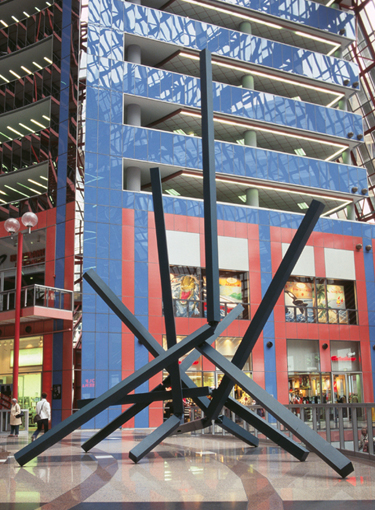Artist:
John Henry
Title:
Bridgeport
Year:
1984
Adress:
Thompson Center
www.chicagoartmagazine.com:
Overall, Bridgeport recalls the visionary drawings and paintings of the Russian Avant-Garde, Tatlin in particular, but what the Russians dreamed, Henry built. The details suggest a Franz Kline influence—remember that Henry started out as a painter. A closer look at the photographs (visit the original too!) suggests that Henry’s work succeeds because he takes great care with scaling and proportioning each element in his sculptures.
Two pieces that got the Finn treatment are located in downtown Chicago, which makes them accessible. Bridgeport (1984), the first of these, is the blue-gray aluminum sculpture, 35 ft high by 25 ft long by 15 ft wide that we see in the lobby of the James Thompson Center. Finn publishes five color photographs of Bridgeport from different angles, essentially walking the reader around it. He also provides ten detail shots, which show how the sculpture was made—and suggest some of Henry’s influences.
In 1977, Henry and Mark di Suvero, Jerry Peart, Charles Ginniver, Linda Howard, Lyman Kipp, Kenneth Snelson, and Frank McGuire founded Construct Gallery in Chicago, a for-profit venture that showed artist members and toured group exhibitions. Construct Gallery lasted for ten years and helped to establish large-scale sculpture all over the United States.
In 1978, the Chicago City Council approved the Percent for Art Ordinance, which stipulates that 1.33% of the cost of constructing or renovating municipal buildings and public spaces be devoted to original artwork on the premises. The Ordinance also stipulates that at least half of the commissions be awarded to Chicago area artists. Chicago was one of the first cities to pass such an ordinance; we now have more than 200 nationwide. Percent for Art put public sculpture in many more places than it had ever been seen before—and put money into the pockets of sculptors. Henry and his colleagues had helped to create the climate in which Percent for Art became possible.
By 1980, Henry was spending more and more time in Florida where he found generous patrons and could work outdoors all winter. After some years in Florida, he moved to Kentucky, and then to Chattanooga, Tennessee, where he now employs roughly twenty people to help him build large sculptures and manage worldwide gallery relationships. Early this year, Henry was commissioned to build a 302-foot-tall illuminated steel sculpture in a public park along the Baltimore waterfront. Work on this project—a sculpture that’s taller than the Statue of Liberty– will begin in 2012.
Overall, Bridgeport recalls the visionary drawings and paintings of the Russian Avant-Garde, Tatlin in particular, but what the Russians dreamed, Henry built. The details suggest a Franz Kline influence—remember that Henry started out as a painter. A closer look at the photographs (visit the original too!) suggests that Henry’s work succeeds because he takes great care with scaling and proportioning each element in his sculptures.
Two pieces that got the Finn treatment are located in downtown Chicago, which makes them accessible. Bridgeport (1984), the first of these, is the blue-gray aluminum sculpture, 35 ft high by 25 ft long by 15 ft wide that we see in the lobby of the James Thompson Center. Finn publishes five color photographs of Bridgeport from different angles, essentially walking the reader around it. He also provides ten detail shots, which show how the sculpture was made—and suggest some of Henry’s influences.
In 1977, Henry and Mark di Suvero, Jerry Peart, Charles Ginniver, Linda Howard, Lyman Kipp, Kenneth Snelson, and Frank McGuire founded Construct Gallery in Chicago, a for-profit venture that showed artist members and toured group exhibitions. Construct Gallery lasted for ten years and helped to establish large-scale sculpture all over the United States.
In 1978, the Chicago City Council approved the Percent for Art Ordinance, which stipulates that 1.33% of the cost of constructing or renovating municipal buildings and public spaces be devoted to original artwork on the premises. The Ordinance also stipulates that at least half of the commissions be awarded to Chicago area artists. Chicago was one of the first cities to pass such an ordinance; we now have more than 200 nationwide. Percent for Art put public sculpture in many more places than it had ever been seen before—and put money into the pockets of sculptors. Henry and his colleagues had helped to create the climate in which Percent for Art became possible.
By 1980, Henry was spending more and more time in Florida where he found generous patrons and could work outdoors all winter. After some years in Florida, he moved to Kentucky, and then to Chattanooga, Tennessee, where he now employs roughly twenty people to help him build large sculptures and manage worldwide gallery relationships. Early this year, Henry was commissioned to build a 302-foot-tall illuminated steel sculpture in a public park along the Baltimore waterfront. Work on this project—a sculpture that’s taller than the Statue of Liberty– will begin in 2012.



